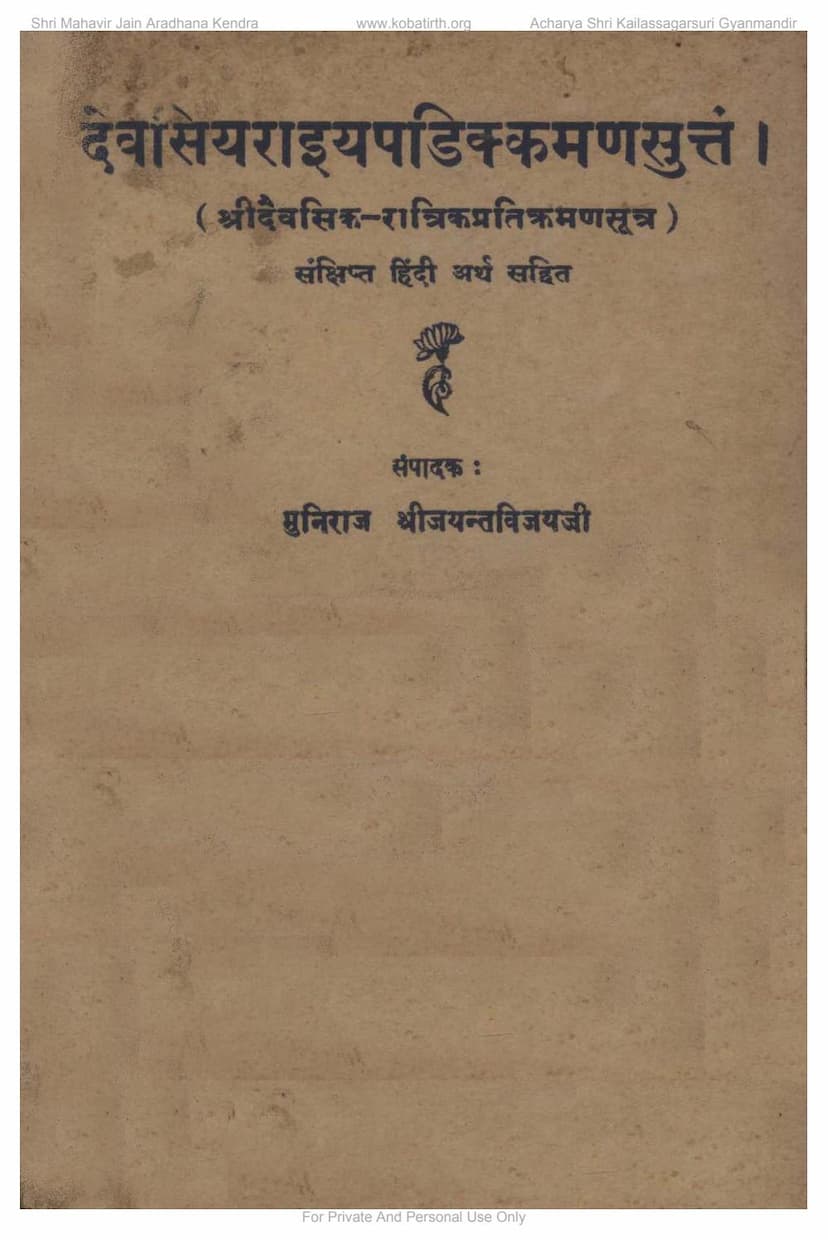Devasia Raia Padikkamana Suttam
Added to library: September 1, 2025

Summary
This Jain text, "Devasia Raia Padikkamana Suttam" (Shri Dasik-Ratrik Pratikraman Sutra) edited by Muni Raj Shri Jayantvijayji and published by Akhil Bharatiya Rajendra Jain Navyuvak Parishad, is a comprehensive guide to the daily and nightly pratikraman (repentance and confession) rituals in Jainism.
The book aims to provide a detailed understanding of these essential practices, going beyond mere recitation to emphasize the meaning, import, and essence of each step. The preface highlights the importance of these ritualistic actions in achieving self-realization and spiritual progress.
Key Features and Content:
- Sarth Version: The book is presented as a sarth (with meaning) edition, indicating that it includes explanations and interpretations of the sutras (scriptural verses). This is crucial for devotees to grasp the deeper significance of their religious practices.
- Comprehensive Scope: The table of contents (Pages 7-11 and 12-43) reveals an extensive list of sutras and topics covered, which include:
- Core Mantras and Prayers: Paramashthimantra Sutram (Namokar Mantra), Panchindriya Sutra, Khama-Samana Sutra (requesting forgiveness), Su-Guru ko Sukh Shata Puchha Sutra (inquiring about the guru's well-being), Iriyavahiya Sutra (repentance for harm to living beings during movement), Annath Sutra (forgiveness for breakages in meditation), Logassa Sutra (Praise of the Tirthankaras), Samayik Sutra (rules for equanimity and meditation), Jaggachintamani Chaityavandana Sutra, Jankichis Sutra, Namosthunam Sutra (Shakrastav), and various other stotras (hymns) praising Tirthankaras and Siddhas.
- Repentance and Confession: Detailed sections on Devasik Aloü Sutra (daily confession), Ashtadash Papasthanaka Lochana Sutra (confession of eighteen cardinal sins), and Vanditru (Shraddha Pratikraman) Sutra (repentance for lay followers).
- Discipline and Vows: Instructions and prayers related to Pachamahavrata (five great vows), Anuvratas (minor vows), and Sikshavratas (training vows).
- Ritual Procedures: Explanations for taking Samayik (meditation period), Samayik Parana (breaking the meditation period), and the specific procedures for Daivsik (daily) and Ratrik (nightly) pratikraman.
- Eulogies and Praise: Numerous stotras and sajjhay (songs of praise) dedicated to various Tirthankaras (Adinath, Shantinath, Parshvanath, Mahavir, Neminath, etc.) and significant Jain figures.
- Ethical Teachings: Topics like Vyasan Nishedhopadesh Pad (advice against vices) and Jain Diwali Pujan Vidhi (Jain Diwali worship method) are included.
- Sutak Vichar (Impurity Rules): Detailed guidelines regarding impurity periods related to birth and death, and Rutuvanti Sambandhi Sutak Vichar (impurity rules for menstruating women).
- Explanation of Mudras and Postures: The text includes illustrations and explanations of various postures (mudras) used during pratikraman and worship, such as Namaskar Mudra, Vandan Mudra, Kayotsarg Mudra, and Samayik Mudra.
- Illustrative Content: The book features illustrations (Pages 15-18) depicting:
- The Namaskar Mahamantra.
- The correct posture for Vandan (salutation).
- Kayotsarg (meditative standing posture) techniques.
- The proper posture for Samayik and Muhapatti (mouth cloth) handling.
- Various mudras used in worship.
- Guidance on Practices: The text provides specific guidance on the timing for wearing blankets, using warm water, and performing certain sajjhay on specific days. It also details common temple transgressions (Jinamandir ki 5 Badi Ashatanaen) and the fourteen daily rules for a Jain lay follower (Shravak ko Nitya Dharne Yogya 14 Niyam).
- Emphasis on Purity and Devotion: Throughout the text, there's a strong emphasis on sincerity, devotion, and performing rituals with correct understanding and intent. The explanations clarify the purpose behind each action, ensuring that the practitioner engages with the ritual on a deeper, more meaningful level.
- Disciplinary and Doctrinal Discussions: The latter part of the book includes a question-and-answer section addressing various practical aspects of Jain practice, including the order of performing certain sutras, the importance of guru-vandan, the correct way to perform samayik, and clarifications on the authenticity of certain verses and practices. It also critically examines practices like worshipping minor deities or performing rituals for worldly gains, advocating for adherence to the core principles of Jainism.
Overall Purpose:
The "Devasia Raia Padikkamana Suttam" serves as an indispensable resource for Jain practitioners, particularly lay followers (shravaks and shravikas), to perform their daily and nightly pratikraman with correctness, devotion, and understanding. It aims to foster a deeper connection with the Jain path by explaining the philosophy and significance behind each prayer, ritual, and ethical guideline. The inclusion of Hindi translations and explanations makes it accessible to a wider audience within the Jain community.